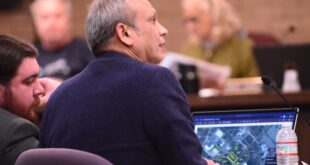
In a scathing decision in which he called out what he said was the Planning Board’s “unmitigated hypocrisy,” a state Superior Court judge recently overturned the Board’s denial of a controversial two-warehouse development near the Canal Walk housing development.
In his 41-page decision filed on April 24, Superior Court Judge William Mennen, sitting in Flemington, excoriated the Board for the stated reasons behind its denial of the so-called B9 application, and to a lesser extent the Township Council for what he called an imprecise ordinance regarding warehouses.
In his order, the Judge sent the approved application back to the Planning Board “for the imposition of reasonable conditions associated with the approvals granted herein. Said limited remand shall be based upon the record already created … This will permit the Board to interact with the Plaintiff to suggest changes and conditions.”
The application, known as B9 Schoolhouse Road, was unanimously denied by the Board on September 26, 2023 after eight hearings spanning months.
The application called for the construction of one 144,450-square foot warehouse and one 70,970-square-foot warehouse on a 20-acre plot at Schoolhouse Lane and Mettlers Road.
Board hearings had to be held in the Board of Education’s community room on Route 27 due to the large number of observers. Each meeting attracted close to 200 attendees, mostly from Canal Walk.
The audiences were not shy to convey their support or opposition to testimony or statement, a fact that was not overlooked by the Judge in his decision.
“While the Plaintiff suggest that the transcripts evidence numerous instances of the Board Chair and Board Attorney admonishing members of the public for their disruptive behavior, the transcripts don’t fully document the insolence exhibited – booing, interrupting, cheering, shouting, etc.,” Mennen wrote.
Mennen wrote that he did not envy the position the Board found itself in on this application.
“They were seen as the last line of defense against what an impassioned and vocal citizenry had grown to revile – warehouse development,” he wrote. “Warehouse development, once considered the darling of those seeking to limit residential development, had fallen largely out of favor. Yet, it remained a permitted use in Franklin Township at the time of the Plaintiffs applications. This placed the Board in the unenviable position of having to choose between its neighbors and a seemingly outdated (in so far as it represented the will of the municipality) ordinance.”
“While the governing body was in the process of removing warehouse development as a permitted use, the Board was forced to absorb the incoming firestorm the Plaintiffs applications stoked,” he wrote.
“Sympathetic though the Court may be, the fact remains that the Applications were conforming applications for a permitted use,” the Judge wrote. “That simple fact severely limited the Board’s ability to deny the Applications. Instead, the Board should have used its local knowledge to engage with the Plaintiff to fashion appropriate and reasonable conditions and plan amendments to arrive at the best possible development. Instead, the Board assumed an all or nothing posture and took the ‘drastic action’ of denying an application for a permitted use.”
The Judge also said that part of the untenable position in which the Board found itself was due to the wording of the Council’s site plan ordinance.
“Worse yet, that denial came at the hands of an imprecise, non-specific, and vague statement of principles couched as the Township’s site plan ordinance,” he wrote.
“A principle is a lower level of criterion,” he continued. “A standard, like those enumerated in
the operative zoning ordinance, is a higher and more definitive level of criterion. A principle
informs a standard but is not a standard itself.”
“Relying on such imprecision is the essence of arbitrariness,” he wrote. “Applying non-specific guidance to meet the din of vocal public outcry is capricious to its core. Usurping the legislative function reserved for the governing body by blocking a permitted use isn’t just unreasonable, it’s contrary to law.”
The Board’s memorializing resolution codifying its decision included a number of aspects of the Township Code it alleged the application violated, including: it’s not “in harmony” with the surrounding area, does not maintain the general welfare of the township, fails to promote the health, safety, order, efficiency, and economy of the township, didn’t address potential hours of operation, didn’t refute the testimony of the objector’s engineer, and did not demonstrate the adequacy of proposed buffering.”
Mennen dismissed that section of the code as “vague and nondescript,” and said that it “serves as little more than a statement of how a reviewing land use board should review an application.”
“It is a statement of principles rather than a set of standards,” he wrote.
“In denying the application, the Board found that the Application ‘is not in harmony with surrounding uses’,” Mennen wrote. “Yet there is no detail explaining how or what aspect of the project is not in harmony with surrounding uses. Instead, there’s a record … which is replete with assertions that the use itself should not be allowed on the site.”
“Through the course of its 23-page resolution, the Board only mentions ‘harmony’ once – in the paragraph finding that the proposed development ‘is not in harmony with surrounding uses’ while providing no explanation.
“This Court finds the requirement that the Board review an application for ‘harmony with surrounding uses’ little more than a guiding principle,” he wrote. “It lacks the certainty and definiteness a specific standard enumerates. Therefore, it was not an appropriate bases to deny the Plaintiff’s Application.”
“It was arbitrary, capricious, and unreasonable,” he wrote. “Instead, the Board should have used its statutorily contemplated active involvement in the process to suggest revisions and modifications based upon their expertise and familiarity with local conditions.”
“Prohibiting a permitted use is an unlawful usurping of the legislative authority to zone vested exclusively with the governing body,” the Judge wrote.
“The Board also expressed ‘significant concerns relative to the health, safety, and general welfare of the residents of the surrounding area,” the Judge wrote. “A planning board evaluates applications with the public health and welfare in mind only in so far as whether a site plan or subdivision proposal conforms to the municipal ordinance(s). It is those ordinances which should advance health, safety, and the general welfare. That is a legislative function.”
“The Court further notes the unmitigated hypocrisy in the Board’s improvident ‘concerns’ related to health, safety, and welfare,” the Judge wrote. “When the applicant’s engineer testified … that he had no concerns about the health, safety, and well-being of the community from the application, he was castigated for giving such an opinion without being a medical doctor. The Board suggested his statement be stricken from his report. Under what appears to be pressure from the Board, the engineer relented.”
“Yet, while the record is devoid of testimony from any medical doctor on this issue, the Board felt free to express its ‘significant concerns’ without the benefit of any qualified (by its own ‘medical doctor’ criterion) testimony,” the Judge wrote.
 The Franklin Reporter & Advocate Eight Villages, One Community
The Franklin Reporter & Advocate Eight Villages, One Community

